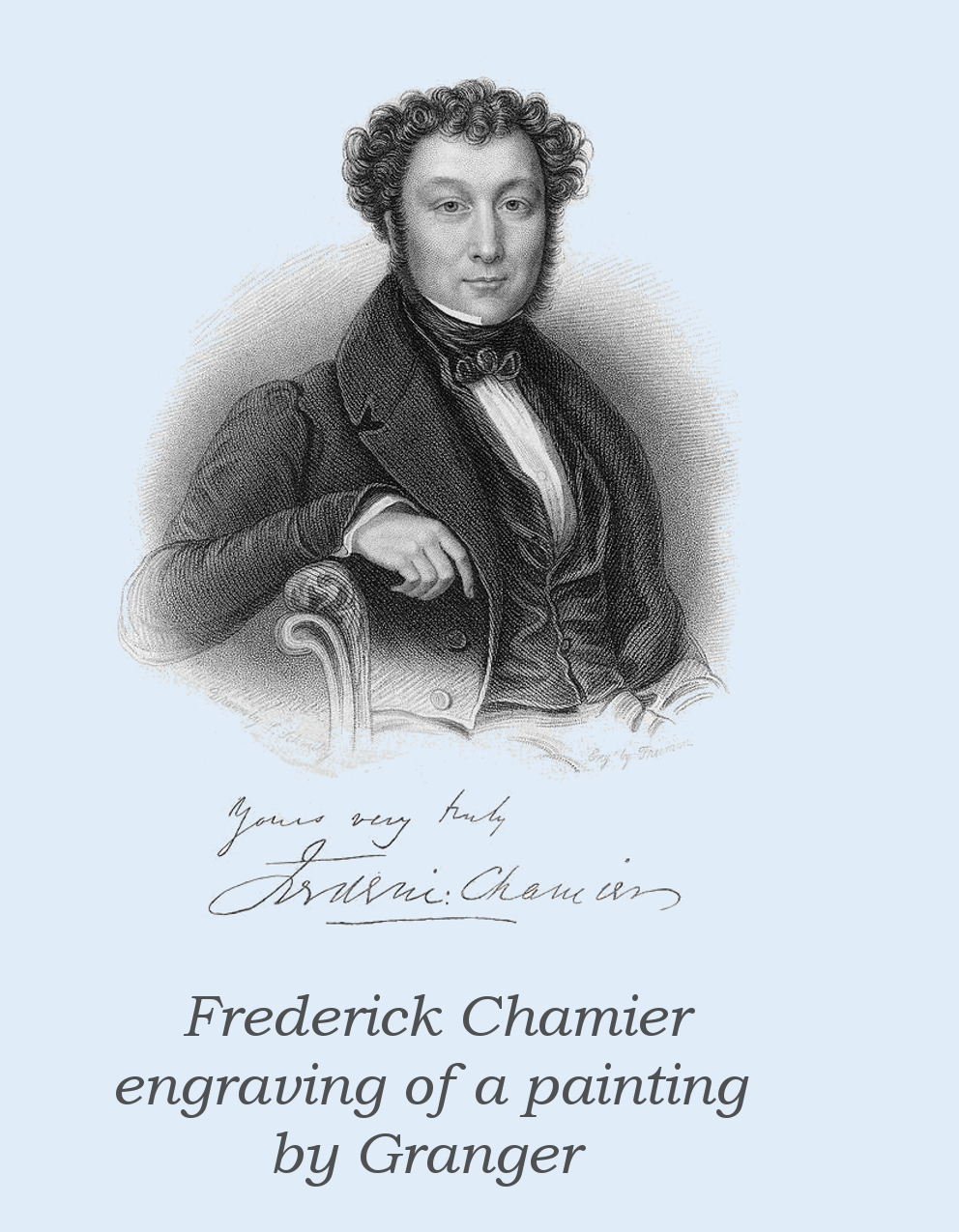
Frederick Chamier
 Biography
BiographyFrederick Chamier (November 2, 1796–October 29, 1870) was an English novelist, autobiographer, and naval captain, the author of several nautical novels that remained popular throughout the 19th century. He laid claim to being descended from the 17th-century French Huguenot politician Daniel Chamier.
Born the son of an Anglo-Indian official, John Ezechial Chamier, and his wife Georgiana, daughter of Vice-Admiral Sir William Burnaby, the family home was in Grosvenor Place, London. He entered the Royal Navy in June 1809, joining the frigate Salsette as a midshipman in time for the Walcheren Campaign. After the campaign the Salsette was ordered to the Mediterranean and while at Smyrna in April 1810 he met with Lord Byron, who, on hearing the ship was making for Constantinople, asked Captain Bathurst for a lift. Byron took a friendly interest in the young Chamier and when the ship stopped en-route at Tenedos within sight of the plains of Troy, prevailed on the captain to allow the boy ashore to carry his fowling piece. There Byron sat down on the tomb of Patroclus and pulled out his copy of Homer and read for his companions. Chamier would become a lifelong devotee and sprinkle his own books in the future with many Byronic quotations. Later in May 1810, Chamier watched Byron on his famous swim across the Hellespont from Europe to Asia at the second attempt, describing the episode in his autobiography. Once in Constantinople the young midshipman accompanied his captain to various receptions and audiences for Sir Robert Adair with the sultan Mahmud II. Bathurst was promoted in November 1810 to command the 74-gun Fame and took Chamier with him. Later Chamier went on to serve in the mediterranean on the Arethusa, fighting the slave trade. This was followed from October 1811 to 1814 on board the Menelaus under Sir Peter Parker. He was onshore with Parker when the latter was killed at Bellair on 30 August 1814. In July 1815 he was promoted lieutenant, and continued service in the Mediterranean and the West Indies. From September 1824 to August 1825 he was first lieutenant on the Scylla. He was on the West Indies station in August 1826 when he was put briefly in command of the 10-gun brig Britomart for bringing her home to England, and thereafter was very soon paid off. He took no further employment and in 1833 was placed on the retired list of the navy, on which he was formally promoted captain on April 1, 1856.
Effectively retired in 1827, he settled down to the life of an Essex county squire, dividing his time between his house in Halkin Street, Belgravia, and Paris. His autobiography, The Life of a Sailor, was serialised in The Metropolitan Magazine in 1831–1832. At the tail end of 1831 Chamier lost a considerable sum in a failed venture, the premature establishment of The Metropolitan Magazine, which his friend Frederick Marryat would make something of later that same year. Licking his wounds in Paris he met his future wife Bessie Soane in January 1831. The couple wished to marry but Bessie’s guardian, Sir John Soane, refused permission, despite Chamier on the face of it being a man of means: his father had left him a legacy of £10,000 and his writing at that stage was earning him £300 a year. The couple clandestinely eloped to Gretna Green. The couple remarried in Esher that April in an unsuccessful bid to placate the family, to no result, and went off to live in Paris. Their only child Elizabeth was born there. Chamier invested heavily in the railways and was at various times a director of several companies. He had been in Paris during the revolution of February 1848, and published an account of that period under the title A Review of the French Revolution of 1848, in which he depicted the main personages taking part in the events.
Chamier held for some time an official post abroad, but retired to Warrior Square, St Leonards-on-Sea, where he died after a lingering illness, survived by his wife. The couple are buried in Hastings Cemetery.
Bibliography (wildly incomplete)
The Life of a Sailor (autobiography, 1831)
The Young Muscovite; or, The Poles in Russia (1834)
The Unfortunate Man (1835)
Ben Brace, The Last of Nelson’s Agamemnons: A Tale of the Sea (1836)
The Arethusa (1837)
Jack Adams, the Mutineer (1838)
The Spitfire (1840)
Tom Bowling (1841)
Count Konigsmark (1845)
Jack Malcolm’s Log (1846)
A Review of the French Revolution of 1848 (1848)
Other links
Historic Naval Fiction
StudyLight.org
Wikipedia